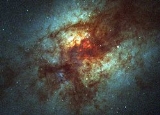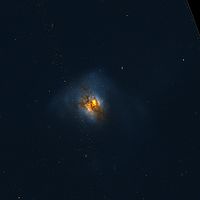
Arp 220
Encyclopedia
Arp 220 is the result of a collision between two galaxies which are now in the process of merging. Located 250 million light-years away in the constellation Serpens
, it is the 220th object in Halton Arp
's Atlas of Peculiar Galaxies
.
 Arp 220 is the closest Ultraluminous Infrared Galaxy (ULIRG) to Earth. Its energy output was discovered by IRAS
Arp 220 is the closest Ultraluminous Infrared Galaxy (ULIRG) to Earth. Its energy output was discovered by IRAS
to be dominated by the far-infrared part of the spectrum.
It is often regarded as the prototypical ULIRG and has been the subject of much study as a result.
Most of its energy output is thought to be the result of a massive burst of star formation, or starburst
, probably triggered by the merging of two smaller galaxies.
Recent (2002 and 1997) HST
observations of Arp 220, taken in visible light with the ACS
, and in infrared light with NICMOS
, revealed more than 200 huge star cluster
s in the central part of the galaxy.
The most massive of these clusters contains enough material to equal about 10 million suns..
X-ray observations by the Chandra
and XMM-Newton
satellites have shown that Arp 220 probably includes an active galactic nucleus
(AGN) at its core, which raises interesting questions about the link between galaxy mergers and AGN, since it is believed that galactic mergers often trigger starbursts, and may also give rise to the supermassive black holes that appear to power AGN.
Luminous far-infrared objects like Arp 220 have been found in surprisingly large numbers by sky surveys of submillimetre wavelengths
using instruments such as the Submillimetre Common-User Bolometer Array (SCUBA) at the James Clerk Maxwell Telescope
(JCMT).
Arp 220 and other relatively local ULIRGs are being studied as equivalents of this kind of object.
Astronomers from the Arecibo Observatory
have detected organic molecules in the galaxy.
Arp 220 contains at least two bright maser sources, an OH megamaser
, and a water maser
.
At October 2011, astronomers have spotted a record-breaking seven supernova
all found at the same time in Arp 220.
Serpens
Serpens is a constellation of the northern hemisphere. It was one of the 48 constellations listed by the 2nd century astronomer Ptolemy and it remains one of the 88 modern constellations defined by the International Astronomical Union....
, it is the 220th object in Halton Arp
Halton Arp
Halton Christian Arp is an American astronomer. He is known for his 1966 Atlas of Peculiar Galaxies, which catalogues many examples of interacting and merging galaxies...
's Atlas of Peculiar Galaxies
Atlas of Peculiar Galaxies
The Atlas of Peculiar Galaxies is a catalog of peculiar galaxies produced by Halton Arp. A total of 338 galaxies are presented in the atlas, which was originally published in 1966 by the California Institute of Technology....
.
Features

IRAS
The Infrared Astronomical Satellite was the first-ever space-based observatory to perform a survey of the entire sky at infrared wavelengths....
to be dominated by the far-infrared part of the spectrum.
It is often regarded as the prototypical ULIRG and has been the subject of much study as a result.
Most of its energy output is thought to be the result of a massive burst of star formation, or starburst
Starburst (astronomy)
In astronomy, starburst is a generic term to describe a region of space with an abnormally high rate of star formation. It is reserved for truly unusual objects....
, probably triggered by the merging of two smaller galaxies.
Recent (2002 and 1997) HST
Hubble Space Telescope
The Hubble Space Telescope is a space telescope that was carried into orbit by a Space Shuttle in 1990 and remains in operation. A 2.4 meter aperture telescope in low Earth orbit, Hubble's four main instruments observe in the near ultraviolet, visible, and near infrared...
observations of Arp 220, taken in visible light with the ACS
Advanced Camera for Surveys
The Advanced Camera for Surveys is a third generation axial instrument aboard the Hubble Space Telescope . The initial design and scientific capabilities of ACS were defined by a team based at Johns Hopkins University. ACS was assembled and tested extensively at Ball Aerospace & Technologies Corp...
, and in infrared light with NICMOS
Near Infrared Camera and Multi-Object Spectrometer
The Near Infrared Camera and Multi-Object Spectrometer is a scientific instrument for infrared astronomy, installed on the Hubble Space Telescope , operating from 1997 to 1999, and from 2002 to 2008...
, revealed more than 200 huge star cluster
Star cluster
Star clusters or star clouds are groups of stars. Two types of star clusters can be distinguished: globular clusters are tight groups of hundreds of thousands of very old stars which are gravitationally bound, while open clusters, more loosely clustered groups of stars, generally contain less than...
s in the central part of the galaxy.
The most massive of these clusters contains enough material to equal about 10 million suns..
X-ray observations by the Chandra
Chandra X-ray Observatory
The Chandra X-ray Observatory is a satellite launched on STS-93 by NASA on July 23, 1999. It was named in honor of Indian-American physicist Subrahmanyan Chandrasekhar who is known for determining the maximum mass for white dwarfs. "Chandra" also means "moon" or "luminous" in Sanskrit.Chandra...
and XMM-Newton
XMM-Newton
The XMM-Newton is an orbiting X-ray observatory launched by ESA in December 1999 on a Ariane 5 rocket...
satellites have shown that Arp 220 probably includes an active galactic nucleus
Active galactic nucleus
An active galactic nucleus is a compact region at the centre of a galaxy that has a much higher than normal luminosity over at least some portion, and possibly all, of the electromagnetic spectrum. Such excess emission has been observed in the radio, infrared, optical, ultra-violet, X-ray and...
(AGN) at its core, which raises interesting questions about the link between galaxy mergers and AGN, since it is believed that galactic mergers often trigger starbursts, and may also give rise to the supermassive black holes that appear to power AGN.
Luminous far-infrared objects like Arp 220 have been found in surprisingly large numbers by sky surveys of submillimetre wavelengths
Submillimetre astronomy
Submillimetre astronomy or submillimeter astronomy is the branch of observational astronomy that is conducted at submillimetre wavelengths of the electromagnetic spectrum. Astronomers place the submillimetre waveband between the far-infrared and microwave wavebands, typically taken to be between a...
using instruments such as the Submillimetre Common-User Bolometer Array (SCUBA) at the James Clerk Maxwell Telescope
James Clerk Maxwell Telescope
The James Clerk Maxwell Telescope is a submillimetre-wavelength telescope at Mauna Kea Observatory in Hawaii. Its primary mirror is 15 metres across: it is the largest astronomical telescope that operates in submillimetre wavelengths of the electromagnetic spectrum...
(JCMT).
Arp 220 and other relatively local ULIRGs are being studied as equivalents of this kind of object.
Astronomers from the Arecibo Observatory
Arecibo Observatory
The Arecibo Observatory is a radio telescope near the city of Arecibo in Puerto Rico. It is operated by SRI International under cooperative agreement with the National Science Foundation...
have detected organic molecules in the galaxy.
Arp 220 contains at least two bright maser sources, an OH megamaser
Megamaser
A megamaser is a type of astrophysical maser, which is a naturally occurring source of stimulated spectral line emission. Megamasers are distinguished from astrophysical masers by their large isotropic luminosity. Megamasers produce roughly 103 times the solar luminosity , which is 100 million...
, and a water maser
Astrophysical maser
An astrophysical maser is a naturally occurring source of stimulated spectral line emission, typically in the microwave portion of the electromagnetic spectrum...
.
At October 2011, astronomers have spotted a record-breaking seven supernova
Supernova
A supernova is a stellar explosion that is more energetic than a nova. It is pronounced with the plural supernovae or supernovas. Supernovae are extremely luminous and cause a burst of radiation that often briefly outshines an entire galaxy, before fading from view over several weeks or months...
all found at the same time in Arp 220.
External links
- Hubble Sees Star Birth Gone Wild (SpaceDaily) Jun 16, 2006

